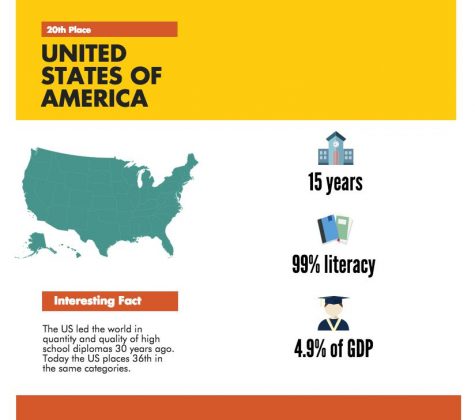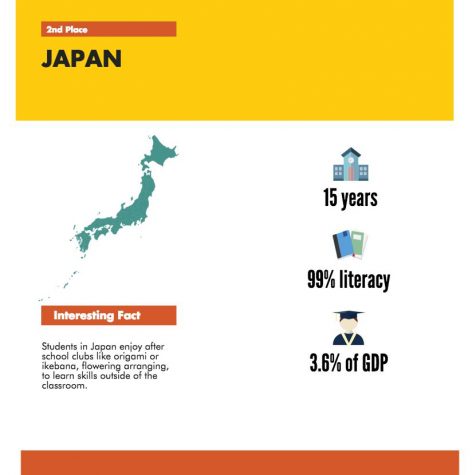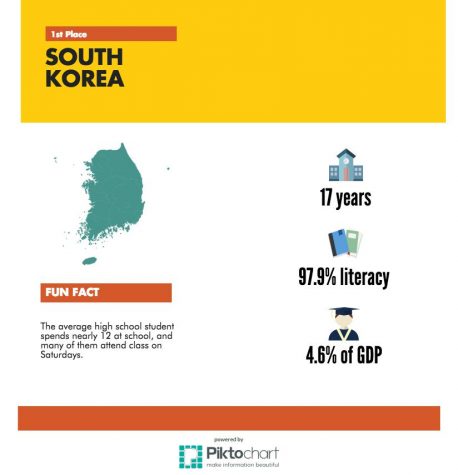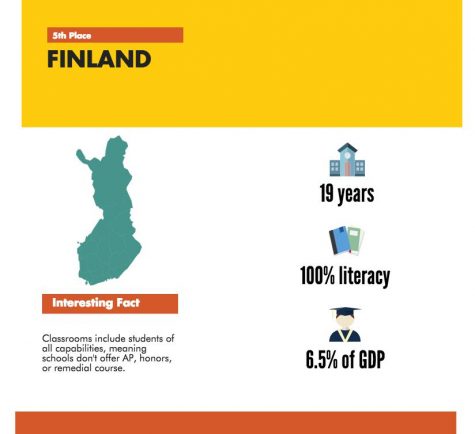Education: A History & A Modern-Day Comparison
May 15, 2017
Students across the world learn about history, but never about the history of education and why they attend classes in public schools. Why did the US develop a test-oriented education system?
Which country outperforms their competitors in schooling and how do they achieve it? The international community must understand the past in order to guarantee the success of their students who will eventually lead their society. Below, The Chant summarizes the history of education systems and holds the world’s best schooling systems up to each other, apples to apples.
History:
Education began as a source of enculturation and socialization for children born into the world’s first societies, an environment where adults of the tribe instill upon them the values, traditions, and history of their people. The youth would learn basic survival skills and how to become a proper member of the group through observation and imitation.
After the development of Mesopotamia, civilizations began to diffuse in other parts of the world, namely India, China, and Egypt. Most formal education systems at the time focused on educating the religious elite who would possess unchecked power in their kingdoms and scribes that would record important events and copy documents, honing in on the humanities, medicine, and primitive forms of math and science. Most common people did not receive the opportunity of attending school, but rather trained in vocational works like architecture or agriculture.
However, while the world’s ever-changing knowledge and technology continued to expand, so did the concept of education. During the Achaemenian period in ancient Persia (559-330 BCE), parents would pay individual businesses to teach their children, but after seven years of age, only upper class students would further their education in fields including law, arithmetics, astronomy, and music.
In Byzantium’s extension of the Roman Empire in 330 CE, the edification of pupils began at the age of six in elementary school where the grammatistes taught reading and writing until the age of ten. Students would then study Greek and Latin metaphysical literature, mostly from the works of Plato and Aristotle, under a guidance of a grammatikos (Greek teachers). At sixteen, pupils would practice argumentative and communication skills with a rhētor, focusing on logic, rhetoric, and philosophy. These famous philosophers’ works would come under the preservation of Islamic caliphates, Umayyad and Abbasid from 661-1100 CE, which developed the mathematical idea of algebra.
Following the establishment of Christianity, the majority religion, the Catholic Church provided the first opportunity for plebeians to attend school in cathedrals and monasteries that centered on religious teachings, embracing the moral values of prudence, temperance, and justice. However, education became individualized during the Renaissance as many teenagers participated in mentorships, ranging from the arts to politics that enabled specialization at a younger age.
The common people, nevertheless, remained mostly illiterate, and the Church’s formal language of Latin did not match their vernacular language; Martin Luther initiated the Protestant Reformation and encouraged language skills to disperse to all Christians in order to read the Bible.
Eventually, states consolidated power and united multiple kingdoms into one country. With the rise of secular thought, the demand for separation between church and state rose, and countries began crafting the modern education system. England’s Industrial Revolution caused a ripple in the country, not only about the rights of workers, but also the rights of children, and ultimately England deemed child labor illegal and passed the Elementary Education Act: with all their newfound free time, the kids spent their time in classrooms. The idea of preparing youth to become meaningful members of their country sprang up again in Germany with the Humboldt’s reforms. France fought for an independent schooling system throughout its revolutions. Russia constructed schools for people of every class.
American history considers Horace Mann as one of the most influential people to shape its education system. The secretary of the first Board of Education in Massachusetts, Mann tasked himself with collecting data on education quality, doubling the monetary appropriations for schools, and establishing the first three state normal schools of the United States. People in other states mirrored Mann’s work, and soon enough the American school model disseminated throughout the country.
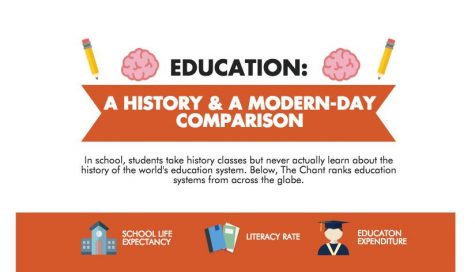
United States
Beginning with the base model for the education comparison, the United States ranks twentieth for best schooling system in the world, averaging scores from sources including World Economic Forum, Independent, The Edvocate, and Fair Reporters. This might shock people considering the US’s high literacy rate (99 percent) and global economic power, but on the other hand, America holds the 24th spot for science and 38th position for math, according to the Programme for International Student Assessment.
The United States also pays less for education percentage-wise than most of its western democratic counterparts, with only 5.9 percent of its GDP in 2008 which decreased to 4.9 percent as of 2013. This decline in funding impacts the lives of students since college tuition costs continue to skyrocket, increasing by 500 percent since 1985. The US Department of Labor estimates that only 69.7 percent of high school graduates attend post-secondary school which explains the country’s low school life expectancy of 17 years compared to higher ranking education systems.
Canada
To the north, Canada holds the position of the eighth highest performing schooling system on the planet. A majority of the provinces in Canada, like all states in the US, require students to complete 16 years of school, but several of them set the compulsory age at 18. Their elevated encouragement for students to receive a high school diploma also enforces increased attendance and graduation for college student. Nearly 24 percent of Canada’s entire population possesses at least an undergraduate degree.
Canada’s education expenditure also decreased in 2013, but at a smaller degree, from 5.3 percent to 5.2 percent. This spending on their school system gives them the same literacy rate of 99 percent like the United States.
Japan
The international community used to recognize Japan as the greatest education system, but it recently dropped to second place. Their school structure contrasts from the American model greatly.
“Japanese students attend elementary school for six years, junior high for three years, and senior high for three years if they pass entrance exams,” Kristin Foxworth-O’Brien, who worked as an Assistant English Teacher, said. “Japanese students may also choose to attend college, but must pass the entrance exams for whatever colleges they apply to. In Japan, it is not compulsory for students to attend senior high school; students may enter the workforce instead. In order to attend high school, students must pass entrance exams, and a huge emphasis is placed on attending a ‘good’ school. The typical school day is around eight hours, much like American schools, with club activities after school sometimes going as late as six or seven in the evening depending on the club. The courses emphasized are very similar to American schools as well, including math, science, and English as a foreign language.”
The arduous process that students go through established Japan’s high regard for learning. Despite high performance in education, which intertwines technology and hard work ethic into the classroom, Japanese students place heavy emphasis on afterschool activities to acquire knowledge outside of class. The country spends 3.6 percent of its GDP of schools where students spend in average of 15 years.
South Korea
South Korea receives the gold medal in the international schooling system field. With an education expenditure of 4.6 percent of its GDP, the Republic of Korea’s allowance for schools falls below countries that do not rank that high, but their performance outshines any of their competition. Much like Japan, South Korean students study nonstop to ensure they pass their entry exams so that they may attend a “good” high school (some students attend classes seven days a week). Also, Korean society praises the teacher, allowing them to enjoy a higher social class and wages compared to teachers in other countries.
However, South Korean schools did not always achieve the success that they display nowadays. After the Korean War, the country estimated a 78 percent literacy, and the average income equaled $200. The government saw education as the only means to pull the country from the destruction and poverty following the North Korean invasion. Since their push to educate all of the population, the literacy rate increased to 97.9 percent because the Ministry of Education “offered financial support to all middle school students, subsidized computers, offered meals and opened more schools in rural areas to make them more accessible.” Additionally, parents in South Korea spend more on their children’s education for tutors or private schools than in any other country, between 15 to 25 percent of their income.
Finland
The former number one seat holder seems to do the exact opposite of its Asian counterparts. Students do not enter formal schooling until the age of seven, where they receive a 15 minute recess for every hour of learning. For Finnish students, they enjoy shorter school days and light homework loads, but maintain high scores on math and reading scores, and 100 percent literacy rate.
Instead of focusing on standardized tests for major assessment, schools grade children daily with “direct observation, check-ins and quizzes by the highest-quality ‘personalized learning device’ ever created — flesh-and-blood teachers,” according to LA Times.
Spending 6.5 percent of their GDP on education, student pay no tuition fees even through university. This enables the country to boast one of the world’s highest average school life expectancies, an estimated 19 years.
The Path for Improvement
In President Trump’s proposed budget plan, he drafts a 14 percent reduction in the funding for the Department of Education which would decrease the $68.2 billion allowance to $59 billion. The slash on the education budget will cause cuts in teacher training, afterschool and summer programs, low-income and first-generation student aid, and work-study aid for college students. However, Secretary of Education, Betsy Devos, emphasizes the importance of school-of-choice programs, so the budget would increase funding for charter schools by $168 million.
Educating the next generation plays a vital role in American society, and teachers lead the charge. Therefore, society should ensure that teachers receive the ideal qualifications by offering training through a master’s degree that the government would help fund.
Furthermore, America’s school system focuses on standardized testing which only teaches students how to fill in circles. These tests unjustly allow colleges to generalize applicants through the SAT or ACT. The school system should not require students to complete other mandated standardized tests until after the age of 13 because they reduce learning time, limits curriculum, and internalizes failure.
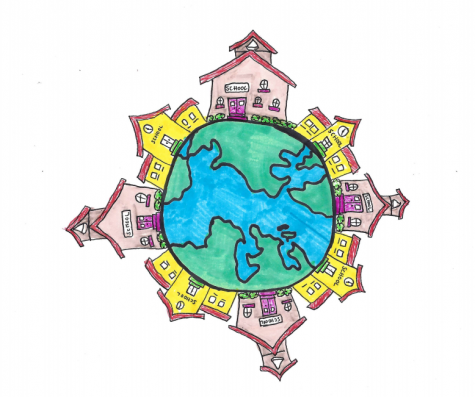
Countries across the world rely on their schools to cultivate proper members of their society. Education systems vary from country to country, but they humanity could not progress without them.

